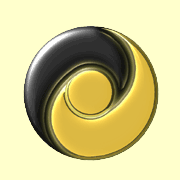May the Force be with you. Utter this famous line and there's no mistaking it. You're referring to the driving force (pardon the pun) behind the Star Wars world of exploding planets and intergalactic wars. But what exactly is it? In the words of the character Obi-wan Kenobi, a Jedi knight:
"The Force is what gives the Jedi his power. It's an energy field created by all living things. It surrounds us and penetrates us. It binds the galaxy together."
Neat. A power in all of us that we can manipulate to, say, blow up an evil empire or control the galaxy. Played out in a world of Jedi knights, princesses and evil Imperial troops, it's a tantalizing basis for a hyper-tech fairy tale. But, as synonymous as the Force is with the make-believe world of Star Wars, some of its basic principles can be found in a real-life, ancient Chinese philosophy called Taoism.
"The Tao is kind of, well, a force that pervades the universe," says Anne Collins Smith, a philosophy and classical studies professor at Susquehanna University in Selinsgrove, Pennsylvania. "It is the source of the universe, but it also IS the universe."
There are enough similarities between the Force and the Tao that Smith, an avid Star Wars fan, uses the movie to help explain concepts in Taoism in her classes. Taoism is one of the two major indigenous religio-philosophical traditions that has shaped Chinese life for more than 2,000 years. A mysterious, master Taoist named Lao-tzu, an archivist at the court of the Chou dynasty (c. 1111-255 BC) and an instructor of Confucius, is said to be one of its founders, after writing a series of poems called the Tao-te Ching.
Tao, often translated as the way or the path, is the ineffable, eternal, creative reality that is the source and end of all things. Te refers to the manifestation of Tao within all things. Thus, to fully possess Te, one must be in perfect harmony with one's original nature.
Put another way, the Tao can be understood in three ways, explains Smith. It is the nature of the universe. It is also your true essence. And it is the way to lead your life. "Really this meaning ties the other two together, because the way to lead your life is to get your personal Tao in touch with the Tao of the whole universe."
Sound familiar? "Be one with the force, Luke," advises his teacher Obi-wan Kenobi, as our hero learns the "ways of the Force".
A key principle in becoming a master Taoist, is wu-wei, sometimes translated as creative inaction. "It literally means getting things done without doing anything," says Smith. But perhaps it's better described as an action that is so well in accordance with things, that there is no evidence of the action. To the Taoist, any deliberate intervention in the natural order of things will eventually turn into the opposite of what was intended and result in failure. And that is a common theme in Star Wars, says Smith.
Take the scene from the first Star Wars movie, where Obi-wan Kenobi is teaching Luke Skywalker the "ways of the Force" on Han Solo's Millennium Falcon. Luke is trying hard to avoid laser blasts from a remote, but fails miserably. When Obi-wan Kenobi places a blaster helmet on his head so he can't see, he easily deflects the remote's laser blasts.
And remember the last battle scene when Luke blows up the Death Star? Several deliberate attempts by the Rebels, using a targeting computer, end in failure. But when Luke, once again listens to Obi-wan Kenobi to "use the Force", he turns off the device and takes a successful shot. "That's really Taoist," says Smith.
One poem in the Tao-te Ching describes the Tao like this:
The Tao is like a bellows:
it is empty yet infinitely capable.
The more you use it, the more it produces;
The more you talk of it, the less you understand.
This idea of doing rather than understanding is paralleled in Luke Skywalker's experiences with his second Jedi teacher, the small, wrinkled Yoda. When Luke tries and fails to lift out his spacecraft from a swamp after trying to get a mental grip on such an impossible-seeming feat, Yoda replies "Try not. Do," and effortlessly raises the ship onto dry land.
But that's where the analogies end. Taoism "celebrates a kind of agrarian lifestyle where people are very much in tune with nature - trees, grass and growing things," points out Smith. "It's against the idea of conscious manipulation of the environment." Not exactly in line with the technology-driven world of Star Wars.
The Force is also expressed as two opposites - good vs. evil, dark vs. light. And on a superficial level, it has a parallel in Taoism. One of its icons is the yin yang symbol. A circle divided in two, it represents the unity of apparent opposites. The Yin represents the dark, death, winter and female side of the universe, while the Yang symboilizes the light, life, summer and male side.
But unlike the theme of the positive energy of the Force overcoming the Dark Side in Star Wars, the two sides are inseparable in Taoism.
"The ethics in Taoism is to respect both the yin and the yang aspects because both are necessary," explains Owen Smith, also a philosophy and classical studies professor at Susquehana University and Smith's husband. "It is a mistake philosophically to try and foster the yang at the expense of the yin."
A mistake for those practicing Taoism, but it's a perfect way to incorporate a mysterious, unidentified religious force into a fairy tale.
Gloria Chang
Taoism Articles
Back to Apprentice Weavers
|
